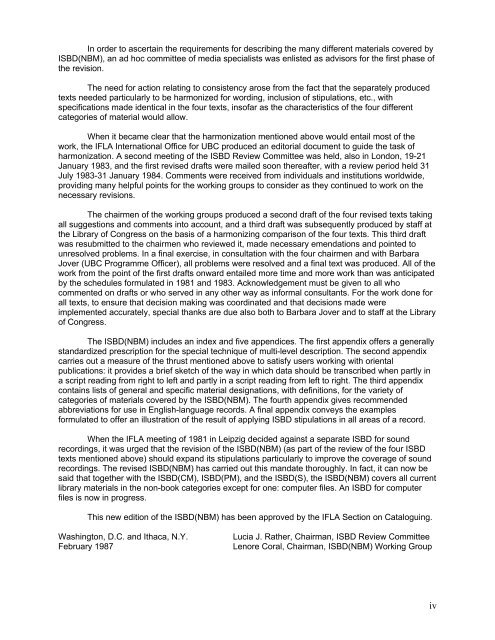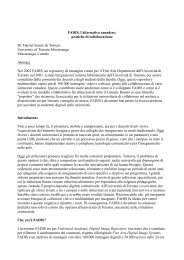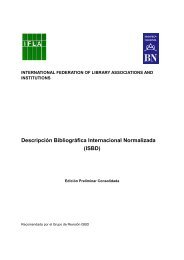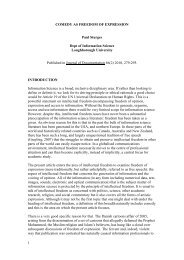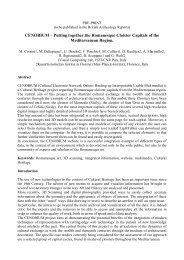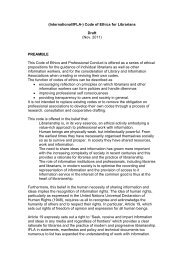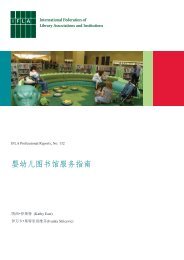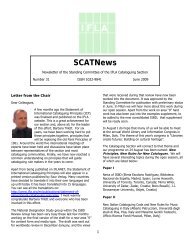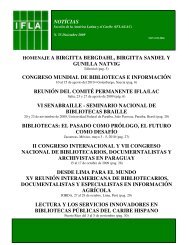ISBD(NBM) - IFLA
ISBD(NBM) - IFLA
ISBD(NBM) - IFLA
Create successful ePaper yourself
Turn your PDF publications into a flip-book with our unique Google optimized e-Paper software.
In order to ascertain the requirements for describing the many different materials covered by<br />
<strong>ISBD</strong>(<strong>NBM</strong>), an ad hoc committee of media specialists was enlisted as advisors for the first phase of<br />
the revision.<br />
The need for action relating to consistency arose from the fact that the separately produced<br />
texts needed particularly to be harmonized for wording, inclusion of stipulations, etc., with<br />
specifications made identical in the four texts, insofar as the characteristics of the four different<br />
categories of material would allow.<br />
When it became clear that the harmonization mentioned above would entail most of the<br />
work, the <strong>IFLA</strong> International Office for UBC produced an editorial document to guide the task of<br />
harmonization. A second meeting of the <strong>ISBD</strong> Review Committee was held, also in London, 19-21<br />
January 1983, and the first revised drafts were mailed soon thereafter, with a review period held 31<br />
July 1983-31 January 1984. Comments were received from individuals and institutions worldwide,<br />
providing many helpful points for the working groups to consider as they continued to work on the<br />
necessary revisions.<br />
The chairmen of the working groups produced a second draft of the four revised texts taking<br />
all suggestions and comments into account, and a third draft was subsequently produced by staff at<br />
the Library of Congress on the basis of a harmonizing comparison of the four texts. This third draft<br />
was resubmitted to the chairmen who reviewed it, made necessary emendations and pointed to<br />
unresolved problems. In a final exercise, in consultation with the four chairmen and with Barbara<br />
Jover (UBC Programme Officer), all problems were resolved and a final text was produced. All of the<br />
work from the point of the first drafts onward entailed more time and more work than was anticipated<br />
by the schedules formulated in 1981 and 1983. Acknowledgement must be given to all who<br />
commented on drafts or who served in any other way as informal consultants. For the work done for<br />
all texts, to ensure that decision making was coordinated and that decisions made were<br />
implemented accurately, special thanks are due also both to Barbara Jover and to staff at the Library<br />
of Congress.<br />
The <strong>ISBD</strong>(<strong>NBM</strong>) includes an index and five appendices. The first appendix offers a generally<br />
standardized prescription for the special technique of multi-level description. The second appendix<br />
carries out a measure of the thrust mentioned above to satisfy users working with oriental<br />
publications: it provides a brief sketch of the way in which data should be transcribed when partly in<br />
a script reading from right to left and partly in a script reading from left to right. The third appendix<br />
contains lists of general and specific material designations, with definitions, for the variety of<br />
categories of materials covered by the <strong>ISBD</strong>(<strong>NBM</strong>). The fourth appendix gives recommended<br />
abbreviations for use in English-language records. A final appendix conveys the examples<br />
formulated to offer an illustration of the result of applying <strong>ISBD</strong> stipulations in all areas of a record.<br />
When the <strong>IFLA</strong> meeting of 1981 in Leipzig decided against a separate <strong>ISBD</strong> for sound<br />
recordings, it was urged that the revision of the <strong>ISBD</strong>(<strong>NBM</strong>) (as part of the review of the four <strong>ISBD</strong><br />
texts mentioned above) should expand its stipulations particularly to improve the coverage of sound<br />
recordings. The revised <strong>ISBD</strong>(<strong>NBM</strong>) has carried out this mandate thoroughly. In fact, it can now be<br />
said that together with the <strong>ISBD</strong>(CM), <strong>ISBD</strong>(PM), and the <strong>ISBD</strong>(S), the <strong>ISBD</strong>(<strong>NBM</strong>) covers all current<br />
library materials in the non-book categories except for one: computer files. An <strong>ISBD</strong> for computer<br />
files is now in progress.<br />
This new edition of the <strong>ISBD</strong>(<strong>NBM</strong>) has been approved by the <strong>IFLA</strong> Section on Cataloguing.<br />
Washington, D.C. and Ithaca, N.Y.<br />
February 1987<br />
Lucia J. Rather, Chairman, <strong>ISBD</strong> Review Committee<br />
Lenore Coral, Chairman, <strong>ISBD</strong>(<strong>NBM</strong>) Working Group<br />
iv


